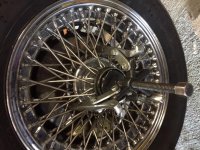Speaking of applying heat, a little may help more than one thinks. It may not take an oxy-acetylene torch or even a propane torch to make things move.
One of the great tools that I found a few years ago is a digital/lcd DeWalt heat gun, adjustable up to 1100 degrees Fahrenheit. (Bought that after the last Chinese-made junk heat gun failed after a short time.) Liberal shots of Lloyds MOOVIT penetrating oil and then judicious use of the heat gun gets the oil bubbling and penetrating into the deep recesses. Bolts that I did not expect to come loose came loose, without damaging anything.
One of the great tools that I found a few years ago is a digital/lcd DeWalt heat gun, adjustable up to 1100 degrees Fahrenheit. (Bought that after the last Chinese-made junk heat gun failed after a short time.) Liberal shots of Lloyds MOOVIT penetrating oil and then judicious use of the heat gun gets the oil bubbling and penetrating into the deep recesses. Bolts that I did not expect to come loose came loose, without damaging anything.

 Hi Guest!
Hi Guest!

 smilie in place of the real @
smilie in place of the real @
 Pretty Please - add it to our Events forum(s) and add to the calendar! >>
Pretty Please - add it to our Events forum(s) and add to the calendar! >> 


